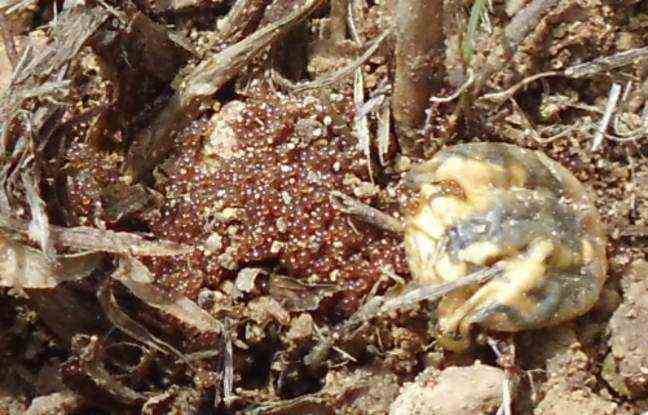It is the nightmare of hikers, nature lovers or even breeders. Everyone wants to avoid the tick, whose bite can wreak havoc on humans and animals – and in particular transmit Lyme disease. How to fight against this mite, an almost invisible enemy before it is gorged with blood? A viral post on Facebook offers a lead: the destruction of eggs.
This message, shared more than 95,000 times in three weeks, advises Internet users to “burn” or “destroy” tick eggs. It comes with a photo showing clusters of eggs that are black or brown in color. The post, however, does not give the source of the photo, nor does it specify where and when it was taken.
FAKE OFF
This image is old: it was taken in the summer of 2008 in Arizona, USA, recalls for 20 minutes Jacob Kalichman, who
posted the image on his Flickr account. He explained at the time that they were tick eggs, but today he is not so sure. “I cannot guarantee that the subject [de la photo] or really tick eggs, and at this point, I go for slime mold [des organismes unicellulaires]. I showed the photo today [mercredi] to a Facebook group of slime mold enthusiasts, and they couldn’t decide one way or the other, ”he told 20 minutes.
To be sure, we showed this photo to several tick specialists. The egg track of this mite is plausible, according to them, but the absence of a scale to compare the size of the clusters visible in the photo prevents a definitive conclusion in this direction.
Difficult to know what the photo shows
Their shape, as well as the presence of brown eggs, visible in the foreground, correspond to tick eggs. The matte black color, on the other hand, is unusual. These could be dead eggs that have been exposed to the sun, an unusual case, with females usually laying in sheltered places.
Their arrangement is also unusual, the eggs are usually collected in a cluster, as can be seen in this photo by Frédéric Stachurski, a researcher in parasitology at CIRAD, taken last year in the vicinity of Montpellier.

“Usually tick eggs are clustered together, because the female, once she has started, lays continuously for several weeks in one place – the length of time depends on the species, the weight of the female, and the size. temperature, ”explains the scientist. The dispersion visible in the photo “could however be due to the action of the photographer who would have spread the eggs a little”.
Female ticks lay eggs in the shelter
Either way, during your walks or hikes, you have a slim chance of falling on tick eggs. One would have to have a very keen eye and rake forest litter to distinguish them, due to the microscopic size of the eggs.
In addition, females lay eggs in protected places. Among the 900 species currently known in the world, hard ticks are the most common in France. And these lay in the litter, a protected place, reminds 20 minutes Sarah Bonnet, research director at INRAE. An act that aims to protect the eggs and larvae, underlines the specialist. Female ticks lay “2,000 to 20,000 eggs” in a single clutch, then die. All these eggs do not evolve into larvae, then nymphs, then adults: “There is a lot of breakage. “
A bad tip …
What about the advice to “burn” or “destroy” these eggs? Eggs of this size seem difficult to set fire to. The risk here is rather accidentally setting fire to the environment where the spawning is located.
What to do then to avoid tick bites? Health insurance recommended to wear long clothes, tight at the wrists and ankles, as well as a hat and closed shoes. She also recommends leaving with a tick puller and, during the walk, to stay on cleared paths.
Once home, a close inspection of the entire body is required, with the tick’s nymph only measuring between 1 and 3mm before it gorges itself with blood. The inspection must be repeated the next day.
In the event of a bite, Health Insurance recommends monitoring it for thirty days, in order to keep an eye out for the appearance of possible symptoms of Lyme disease.

